
Topics
Guests
- Jesse Hagopianauthor, educator and part of the leadership team for the Zinn Education Project.
As Black History Month begins, longtime educator Jesse Hagopian joins us for Part 2 of an interview about the Trump administration and right-wing attacks on education, and his new book, Teach Truth: The Struggle for Antiracist Education. He lays out how “truth crime laws” that criminalize honest education have prompted two out of three teachers to self-censor discussions of race, gender and sexuality. “This is the new McCarthyism,” says Hagopian. “Teachers are scared to teach the truth.” He also describes a “great rebellion” of educators, parents and students who are practicing “fugitive pedagogy” in defiance of “outrageous laws trying to ban the truth.” Hagopian is a longtime educator and high school teacher in Seattle who is on the leadership team of the Zinn Education Project, which draws on historian Howard Zinn’s influential book, A People’s History of the United States. He also serves on the national steering committee of Black Lives Matter at School. His recent article for The Nation is headlined “The Far Right’s Plan to Force Teachers to Lie About Race.”
Transcript
AMY GOODMAN: This is Democracy Now!, democracynow.org, The War and Peace Report. I’m Amy Goodman, with Nermeen Shaikh.
NERMEEN SHAIKH: We turn now to Part 2 of our interview with Jesse Hagopian, longtime educator and high school teacher in Seattle whose new book is titled Teach Truth: The Struggle for Antiracist Education. Jesse is on the leadership team of the Zinn Education Project, which draws on historian Howard Zinn’s influential book, A People’s History of the United States. And he serves on the national steering committee of Black Lives Matter at School.
AMY GOODMAN: Jesse, your recent article for The Nation is headlined “The Far Right’s Plan to Force Teachers to Lie About Race.” I wanted to go to this issue even before President Trump was reelected. You have states across the country that have introduced and passed legislation that forced teachers to change their curricula — for example, Florida, where teachers are required to say chattel slavery in the U.S. was beneficial because it taught them useful skills. Can you, first of all, talk specifically about what they’re supposed to teach, and then respond to this?
JESSE HAGOPIAN: Yes. It’s an astounding situation in our country right now, where even before Trump took office, almost half of all public school children are subjected to laws that require their teacher to lie to them about racism, Black history, gender, Indigenous history, oppression and just so much of U.S. history. I call these laws truth crime laws, because they criminalize honest education.
And the fact is, the impact goes far beyond just where states have passed these laws, because the fear of retribution for teaching the truth has created such a chilling effect, that’s just so cold, that an incredible two out of every three teachers in this country report self-censoring around discussions of race, gender and sexuality. This is the new McCarthyism, where teachers are scared to teach the truth, because many have been attacked and fired. Many have faced death threats sent to them.
And really, I think that we have to consider the reality of what’s happening now, imposing what we could call post-truth schooling in present-day America. And I think in the boundless satire that is the United States of America, you have a situation where Juneteenth, the oldest commemoration of ending slavery, became a federal holiday at the same time that legislators were making it a truth crime to teach about the origins of the commemoration and why that commemoration was needed, including in Texas, where the holiday originates, right?
And the situation in Florida is completely off the rails. When the official state curriculum in Florida says that slavery was of, quote, “personal benefit” to Black people, we know that we are rapidly returning to the age of Jim Crow and the Confederacy. And, you know, in Florida, teachers sent home permission slips with students to get permission to read books by Black authors. That is how much they fear retribution.
But I do want to stress that this isn’t just in Florida. It isn’t just in the South. It’s not just in red states. This is all across the U.S., even in California, where it’s not likely to pass at a state level to have this kind of a ban. You nevertheless have some 110,000 students across the state in different local school districts that are governed by similar laws as those in Florida.
And here’s the thing: You cannot ban your way to knowledge. You can’t ban your way to truth and justice and freedom. Right? We have to allow school to be a place of critical inquiry, of creativity and imagination. And to do that, we have to defend students’ right to learn.
NERMEEN SHAIKH: So, Jesse, if you could just situate this in the broader history of American public school education? When, would you say — as you call it, a truth crime — when do you think these elisions, these erasures of U.S. history began being taught in schools, or when certain kinds of history was taken away from the curriculum by force by the state?
JESSE HAGOPIAN: Well, I think we need to go all the way back to 1739, when the first anti-literacy laws were imposed in South Carolina as a reaction to the Stono Rebellion that happened in 1739. And, you know, a man named Jemmy led an uprising in South Carolina against slavery, and they marched with a banner that said “Liberty.” And the following year, in South Carolina, they not only put down that rebellion, they banned the ability for people, for Black folks, to ever write that word again.
And we know that after the Civil War, Black people built the first truly public schools in this country, open to all, and the Ku Klux Klan and other white supremacists attacked those schools. They burned down over 600 Black schools during Reconstruction.
And we know that organizations like Daughters of the Confederacy worked tirelessly in the Jim Crow era to extend the Lost Cause narrative that glorified the Confederacy.
We had the Dunning School, out of Columbia University, that was all about trying to claim that Reconstruction was a failure because of Black domination of the government.
And that extends all the way up into modern times, when textbook companies like McGraw Hill claimed that workers — quote, “workers” — were brought over from Africa to work on plantations, not mentioning that they were enslaved and unpaid, in their geography textbook, right?
These are common practices that are about erasing honest history and replacing it with what I call uncritical race theory, the uncritical examination of U.S. history, the uncritical examination of race, and the rejection of any systemic understanding of where racism comes from.
AMY GOODMAN: Jesse, can you talk about your experience in the classroom? You cite in your Nation piece The Washington Post identifying at least 160 educators who lost their jobs or had to resign because they taught about race or LGBTQ issues since — this was as of June 2022. Talk about the pressures people are facing and this whole notion of obeying in advance. Do you find that teachers are changing because they’re afraid?
JESSE HAGOPIAN: Yeah. The attack is hard to overstate. I have a friend, Melissa Tempel, who taught in — taught first grade in a school in Wisconsin, and her students wanted to sing a song for a musical production that they were doing, “Rainbowland.” This isn’t a radical anthem. This is a pop song by Miley Cyrus and Dolly Parton that talks about creating a world where everyone can be themselves. It doesn’t even mention LGBTQ+ identity. And yet, the principal banned the students from being able to sing that song, and the school district upheld that.
And Melissa, on her own time, at home, on a Friday, sent a tweet out saying that she believed her kids had the right to sing that song. They practiced it. They chose it. They wanted to sing it. And she came to school on a Monday, and there was a police officer in the office with a representative from HR that escorted her out of the building. She was fired, and she never had a chance to say goodbye to her young students.
AMY GOODMAN: In fact, Jesse, we had Melissa Tempel on the air after she was fired. This is a part of what she said.
MELISSA TEMPEL: My students heard about this song. The music teacher introduced it to them. They had practiced it a few times with me. And in our daily morning meetings, the person of the day gets to lead the meeting, and then they get to pick a song. And so, “Rainbowland” was the song that they wanted to pick, just the one or two times before I was put on leave.
When I was told that we couldn’t sing it anymore, I wanted to just make a point that when I tweeted about it, my students were obviously devastated. They love the song. They had gotten used to it. But I didn’t view what I was doing as making a complaint. You know, the song had already been taken out of the program. The music teacher was conducting the program. It wasn’t part of my specific job duties.
But in addition to that, it was really horrifying to know that a school district’s — or, I’m sorry, not nondiscrimination — our controversial content policy would go so far as to say that we couldn’t sing “Rainbowland.” So, that’s why I knew people were going to be interested to find out that that had happened. And I knew that it was going to create a lot of public discussion, and I think that’s exactly what it did.
NERMEEN SHAIKH: Well, what was the response, Melissa? Could you elaborate on that?
MELISSA TEMPEL: Overwhelmingly surprise, shock. People were saying, “What’s wrong with the lyrics? What’s wrong with the song?” I mean, if I had a dollar for every time somebody said, “Well, I listened to the song, and I couldn’t figure out what was wrong with it or why they didn’t like it.” You know, it’s a really wholesome song. I equate it to any other song that we would sing. In fact, I would say “Rainbowland” is, ultimately, even more of a first-grade song than something like “Rainbow Connection,” because the message is just such a great piece and, like, you know, coming together song about acceptance.
AMY GOODMAN: That was the fired first-grade teacher Melissa Tempel. Jesse Hagopian, go on.
JESSE HAGOPIAN: You know, in Florida, Amy Donofrio was fired when she taught at Robert E. Lee High School, a high school named after a murderous white supremacist. And she put up a Black Lives Matter flag in her classroom to let her Black students know they were cared for and supported in that room, and she was fired and made an example by the governor there.
We have Matthew Hawn in Tennessee, who taught a lesson about white privilege — right? — and assigned an essay by award-winning author Ta-Nehisi Coates and was fired for allowing kids to think critically about race. These are the types of attacks that are being replicated across the country and creating a chilling effect.
And yet, as we detail in the journal I help to edit, Rethinking Schools, there is a great rebellion occurring of educators and parents and students across this country who are refusing to give in to the fear and the lies. And they’re practicing what Jarvis Givens titles “fugitive pedagogy.” They’re teaching the truth anyway, regardless of laws that try to impose this kind of conformity on them.
And on June 7th, we have our National Teach Truth Day of Action. So teachers are building for that all across the country, as they have the past four years. And right now we’re in the midst of Black Lives Matter at School Week, where thousands of educators across the country are teaching lessons about the Black freedom struggle, and in defiance of these outrageous laws trying to ban the truth.
AMY GOODMAN: Jesse Hagopian, you write in the preface of your book, Teach Truth, “A Promise to My Ancestors.” Talk about your ancestors.
JESSE HAGOPIAN: Yeah, as I began writing this book in 2021, my dad made a stunning discovery. He found out which plantation our family had been enslaved on, in Morgantown, Mississippi, in Lawrence County, Mississippi. And it really changed my life and my family’s life forever. And we knew we had to get down to that plantation. And after some setbacks, we finally made it down there. And we were fortunate enough to run into the man that currently owns the land that had been the plantation our family had been enslaved on. And he showed us a clearing where there was a gravesite where our ancestors had buried each other.
And at that gravesite, we held a ceremony to honor them, where I made a promise to my ancestors, to my enslaved ancestors there, Thomas Lenoir and Laura Ratcliffe Lenoir, that we would never lie about the slavery, the cruelty that they had endured, or the beautiful, radical resistance that they had engaged in to resist slavery, and that we would tell the truth about their story to everybody that we encounter. And, you know, that book and being here with you today is part of fulfilling my promise to my ancestors.
NERMEEN SHAIKH: Well, Jesse, if you could talk about your book in the context also of what you say is uncritical race theory, and how that is kind of the substitute for what happens if you don’t teach critical race theory?
JESSE HAGOPIAN: Yeah. I mean, conversations in the mainstream media today about education are replete with discussions about critical race theory, but I think the real problem in education is uncritical race theory, right? And uncritical race theory is a whitewashed version of history that erases systemic racism, resistance and struggle. It teaches us that the civil rights movement ended what little racism there was in the United States. Uncritical race theory teaches us that the U.S. was founded on equity and, you know, principles of democracy alone, and denies the genocide of Native Americans, the enslavement of my ancestors and so many millions of other African people. And really, uncritical race theorists demand an anodyne telling of history, where the United States was simply delivered by the stork, and they’d rather not look any further into how the country was actually made, lest it offend delicate sensibilities.
So, we see uncritical race theory embedded in too many corporate textbooks that really push a system of thought that teaches that slavery was just incidental to American history, rather than central to the American economy. And we have to work to replace uncritical race theory, this uncritical examination of history, with traditions like ethnic studies, that try to center all of our students’ backgrounds and understand how race was created in this country and perpetuates systemic racism today. We need to be able to teach Black studies and cultural studies to our youth, so that every kid can see themselves in the classroom and understand the contributions of people that look like them to the classroom.
AMY GOODMAN: As we begin to wrap up, Jesse, if you can talk more about what you mean by antiracist education? And talk about the movement in this country where people can tap into it. Of course, the direction of the mainstream, of the administration right now, is exactly to eradicate that. But talk about its rich history.
JESSE HAGOPIAN: Yeah. Well, when we say we want antiracist education in the classroom, we know that uncritical race theorists immediately reply that that’s about shaming white kids — right? — as if all of us social justice educators got into teaching in order to shame any children. It’s an outrageous lie. And in fact, that’s not really what they fear. They know we’re not shaming white children. What they really fear is that we are empowering white children by teaching them about the history of people like the Grimké sisters, who were abolitionists organizing to end slavery, or John Brown or Howard Zinn or Anne Braden or so many other important white freedom fighters who joined in multiracial struggles against systemic racism in this country.
And so, antiracist teaching is about understanding that for too long our textbooks have distorted the story of the American past to erase the struggles and contributions of Black people, of Indigenous people and people of color, and that those stories need to be put back in, because they’re some of the most inspiring, incredible stories of the struggle for democracy and freedom, and that if we are going to create a society worthy of our children, we’re going to need to learn the lessons of how those social movements were created, and learn how to implement those lessons today. And that’s exactly what they fear.
And I’ll just end with a story of how that works. When I first began teaching high school, you know, I was teaching AP U.S. History, and I was using many lessons from the Zinn Education Project, teaching kids about the Seneca Falls Convention, the first women’s rights conference to discuss the fight for women’s suffrage. We were doing lessons about the abolitionist movement, where all the students actually became members of different abolitionist organizations and then had to debate the best methods for ending slavery. Or they were members of the Student Nonviolent Coordinating Committee and had to debate how to end Jim Crow segregation.
And the students who went through my course learning about the social movements in the world were truly put to the test — a test far greater than the AP exam — the following year, when the state Legislature voted to cut billions of dollars from the education budget. And myself and a group of social justice educators went to the state Legislature. We protested. We read out the state Constitution, that demands that education is the paramount duty of our state. And I even attempted to do a citizen’s arrest of the state Legislature for violating our state Constitution. And lo and behold, the officer in the room arrested me instead of the state Legislature.
Well, my students, who had been empowered with the knowledge of social movements, led a walkout against the budget cuts when they learned of my arrest, and demanded an audience with the mayor and were part of an uprising across the city and state that helped win billions more for our schools. And that’s exactly what the uncritical race theorists fear, is an informed youth that knows the lessons of history so they can apply them to today.
AMY GOODMAN: Jesse Hagopian, we want to thank you for being with us, longtime educator, high school teacher in Seattle, Washington. He has a new book out. It’s titled Teach Truth: The Struggle for Antiracist Education. Jesse is on the leadership team of the Zinn Education Project and serves on the national steering committee of Black Lives Matter at School. We’ll also link to your Nation article headlined “The Far Right’s Plan to Force Teachers to Lie About Race.”
To see Part 1 of our discussion about President Trump’s plans to dismantle the Department of Education, go to democracynow.org. As well, see our interview with Melissa Tempel, the first-grade teacher Jesse was talking about, who was fired for a viral tweet in which she criticized her Wisconsin Board of Education’s decision to ban her students from singing “Rainbowland” during a school concert. That song, Miley Cyrus and Dolly Parton. This is Democracy Now! I’m Amy Goodman, with Nermeen Shaikh.

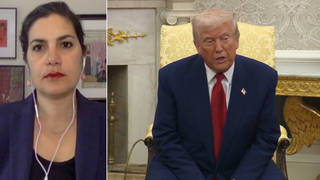
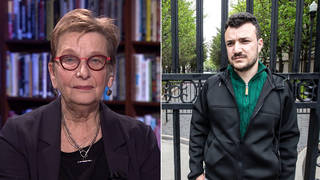
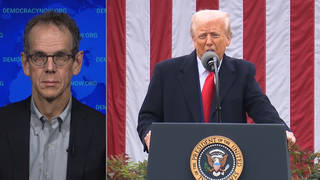
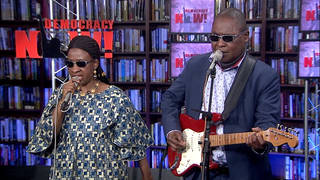
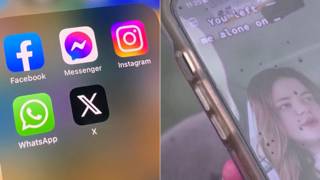

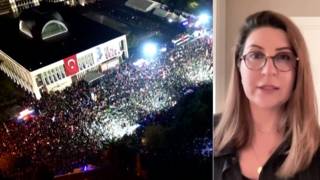
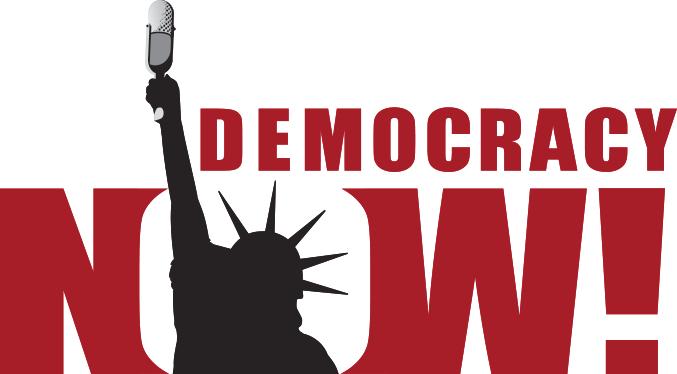

Media Options